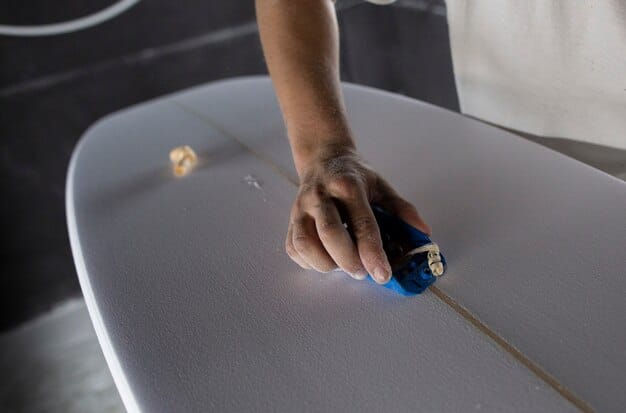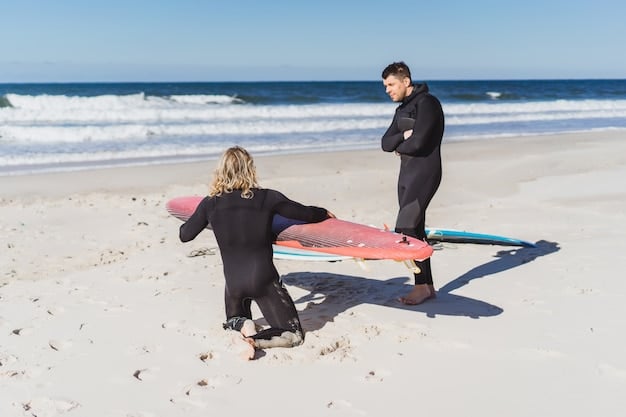Maximize Your Wave Count: The Ultimate Guide to Surfboard Volume in 2025

Maximize your wave count in 2025 by selecting the perfect surfboard volume, a crucial factor influenced by your skill level, body weight, and wave conditions. This guide provides expert insights to help you choose the right board for optimal performance.
Choosing the right surfboard can feel overwhelming, but understanding volume is a game-changer. **Maximize Your Wave Count: Expert Guide to Choosing the Right Surfboard Volume in 2025** will demystify this crucial aspect, helping you catch more waves and improve your surfing experience.
Understanding Surfboard Volume: The Key to Wave Catching
Surfboard volume, measured in liters, essentially determines how easily a board floats. It’s a fundamental characteristic that significantly impacts paddling speed, stability, and overall wave-catching ability. Understanding how volume works is crucial for surfers of all levels.
Think of volume as the board’s buoyancy. More volume generally translates to easier paddling and catching waves, especially in smaller or weaker conditions. However, too much volume can make the board feel bulky and less responsive. Finding the right balance is the key.
Why Volume Matters
Volume plays a vital role in several key aspects of surfing. Here’s a breakdown:
- Paddling Speed: Higher volume boards float higher in the water, reducing drag and allowing for faster paddling.
- Stability: A more voluminous board provides a more stable platform, making it easier to stand up and maintain balance.
- Wave Catching: With increased buoyancy, a board with sufficient volume will catch waves more easily, allowing you to get into the wave earlier.
- Performance: The right volume, tailored to your skill and wave type, enhances overall performance and maneuverability.
Factors like your weight, experience level, and the typical wave conditions you surf in all play a role in determining the ideal volume for your surfboard. Choosing wisely ensures a more enjoyable and productive surfing session.
In conclusion, surfboard volume is a critical factor that impacts paddling, stability, wave catching, and overall performance. By understanding the principles of volume, you can choose a board that suits your specific needs and greatly improve your surfing experience.

Factors Influencing Surfboard Volume Selection
Several factors influence the ideal surfboard volume for you. These elements include your weight, surfing ability, the type of waves you typically ride, and even the specific surfboard design. Tailoring your volume to these factors will significantly enhance your surfing experience.
Ignoring these considerations can lead to a board that feels either too buoyant and unwieldy or too difficult to paddle and catch waves. A balanced approach is essential to maximizing your wave count and enjoyment.
Weight and Fitness Level
Your weight is a primary factor in determining the appropriate volume. Generally, heavier surfers need more volume to compensate for their increased displacement in the water. However, fitness level also plays a role:
- Heavier Surfers: Require more volume to maintain buoyancy and paddling speed.
- Fitter Surfers: Can often handle lower volume boards due to their increased paddling strength and stamina.
- Beginners: Should opt for higher volume to improve stability and wave catching, regardless of weight.
Skill Level and Wave Type
Your surfing ability and the waves you intend to surf in greatly impact the ideal volume:
- Beginners: Should choose boards with higher volumes for stability and ease of paddling in small to medium waves.
- Intermediate Surfers: Can transition to lower volume boards that offer more maneuverability in a variety of wave conditions.
- Advanced Surfers: Often prefer even lower volumes for maximum performance in steeper, more powerful waves.
In conclusion, carefully consider your weight, fitness level, surfing ability, and the waves you will be surfing in order to choose the correct surfboard volume. Making this adjustment can greatly enhance your surfing sessions, allowing for greater stability, control, and wave-catching ability.
Surfboard Volume Calculators: A Double-Edged Sword
Surfboard volume calculators offer a quantitative way to estimate the ideal board volume based on personal attributes like weight and skill level. However, relying solely on these tools can be misleading, as they often fail to account for individual preferences and nuanced wave conditions.
While calculators can be a useful starting point, it’s crucial to cross-reference their recommendations with real-world experience and the advice of experienced surfers or shapers.
How Surfboard Volume Calculators Work
These calculators typically use an algorithm that considers your:
- Weight
- Height
- Skill Level (Beginner, Intermediate, Advanced)
- Age
Based on this information, the calculator provides a volume range in liters that is supposedly ideal for you. Some calculators also factor in your fitness level and the type of waves you plan to surf.
Limitations of Volume Calculators
While helpful, these calculators have several limitations:
- Oversimplification: Calculators often oversimplify complex factors like wave type and personal preference.
- Lack of Personalization: They don’t account for individual paddling strength, balance, or surfing style.
- Inaccurate Skill Level Assessment: Self-assessment of skill level can be subjective and inaccurate.
- Design Variations: A calculator might suggest the same volume for different board types, which drastically changes wave-catching ability.
To summarize, Surfboard volume calculators offer a convenient estimation of surfboard volume, but it’s essential to use them as a tool rather than a definitive answer. Consulting with experienced individuals can offer more tailored advice, leading to a more satisfactory result in your surfing endeavors.

Beyond Numbers: The Importance of Board Shape and Design
While volume is a critical factor, surfboard shape and design play equally significant roles in overall performance. A board with the “right” volume but an unsuitable shape can still be difficult to surf. Understanding how shape complements volume is crucial for optimizing your surfing experience.
Consider length, width, thickness, rocker, and tail shape, as each of these design elements interacts with volume to influence how the board performs in the water.
Length and Width
The length and width of a surfboard directly impact its stability and paddling speed:
- Longer Boards: Generally offer more stability and paddle faster, making them suitable for beginners and smaller waves.
- Shorter Boards: Are more maneuverable but require more skill and effort to paddle.
- Wider Boards: Provide increased stability, while narrower boards are more responsive but less forgiving.
Rocker and Tail Shape
Rocker (the curve of the board from nose to tail) and tail shape influence how the board turns and handles in different wave conditions:
- More Rocker: Helps the board fit into the curve of steeper waves but can reduce paddling speed.
- Less Rocker: Provides faster paddling and speed in flatter waves but can make the board harder to control in steep conditions.
- Tail Shapes: Square tails offer more drive, while rounded tails provide smoother turns.
In summary, while surfboard volume is a crucial factor, surfboard shape and general design are also important in overall performance. Considering these design elements allow for a more optimized and fulfilling surfing experience.
Volume Adjustments for Different Wave Types
The type of waves you typically surf should influence your surfboard volume selection. Different wave characteristics require different board characteristics to achieve optimal performance. Smaller, weaker waves often benefit from more volume, while larger, steeper waves may require less.
Adapting your board’s volume to the specific type of waves you encounter will help you catch more waves, improve your control, and enhance your overall surfing experience.
Small, Weak Waves
For small, weak waves, consider:
- Increased Volume: Extra volume helps the board float easily and paddle quickly in the absence of significant wave power.
- Flatter Rocker: A flatter rocker helps maintain speed in weaker conditions.
- Wider Outline: Wider boards offer more stability and make it easier to catch waves.
Large, Powerful Waves
For larger, more powerful waves, consider:
- Reduced Volume: Less volume allows the board to sit deeper in the water, providing more control in steep conditions.
- Increased Rocker: More rocker helps the board fit into the curve of the wave and prevents nose-diving.
- Pin or Rounded Tail: Narrower tails offer increased hold and control in powerful waves.
In conclusion, the type of waves you may be surfing will influence surfboard volume selection. Adapting your volume to the specific type of waves will assist improve your control and help catch more waves to enhance the surfing experience.
Maintaining Buoyancy Throughout the Years
As surfers age and their physical condition changes, adjusting surfboard volume becomes critical for maintaining enjoyment and performance. Factors such as decreased paddling strength, reduced flexibility, and weight fluctuations can necessitate a change in board volume.
Adapting your equipment to your evolving physical needs ensures you can continue to surf comfortably and effectively throughout the years.
Adjusting for Age and Fitness
Here’s how to adjust your surfboard volume as you age and your fitness changes:
- Increased Volume: As paddling strength decreases, adding volume can compensate for reduced power and stamina.
- Wider Boards: Offer stability and easier paddling for those with reduced flexibility or balance.
- Longer Boards: Provide increased stability and paddle speed, particularly useful for older surfers or those with injuries.
Considering Specific Needs
Additionally, consider addressing specific physical needs:
- Shoulder Issues: A board with more volume reduces the need for strenuous paddling, minimizing strain on the shoulders.
- Back Problems: Wider boards offer a more stable platform, reducing the risk of back injuries during paddling and surfing.
- Knee Issues: Increased volume helps with easier pop-ups, minimizing stress on the knees.
In conclusion, adjusting surfboard volume is critical as age and physical condition changes. By addressing these specific physical needs, comfortability and performance can be insured.
| Key Point | Brief Description |
|---|---|
| 🏄 Volume Importance | Volume affects paddling, stability, and wave catching. |
| ⚖️ Factors Influencing Volume | Weight, skill, and wave type are key considerations. |
| 🧮 Volume Calculators | Use as a starting point, not a definitive answer. |
| 🌊 Adjustments for Waves | Adapt volume based on wave size and power. |
Frequently Asked Questions
▼
Surfboard volume, measured in liters, indicates how well a board floats. It affects paddling speed, stability, and wave-catching ability, making it crucial for surfers of all levels.
▼
Use a surfboard volume calculator as a starting point, but consider your weight, skill level, and typical wave conditions. Consult experienced surfers for personalized advice.
▼
Yes, shape and design elements like length, width, rocker, and tail shape interplay with volume. A board with the right volume but wrong shape can still be difficult to surf.
▼
For small, weak waves, increase volume. For large, powerful waves, reduce volume for better control. Consider rocker and tail shape accordingly.
▼
As you age, increasing volume can compensate for decreased paddling strength and flexibility. Wider and longer boards offer more stability and stability on the water.
Conclusion
Choosing the right surfboard volume is paramount to maximizing your wave count and overall enjoyment in the water. By carefully considering your weight, skill level, the types of waves you surf, and the board’s shape and design, you can select a board that enhances your paddling, stability, and wave-catching ability. Remember that volume calculators are a tool, but real-world experience and personalized advice from experienced surfers or shapers are invaluable for finding your perfect board.





